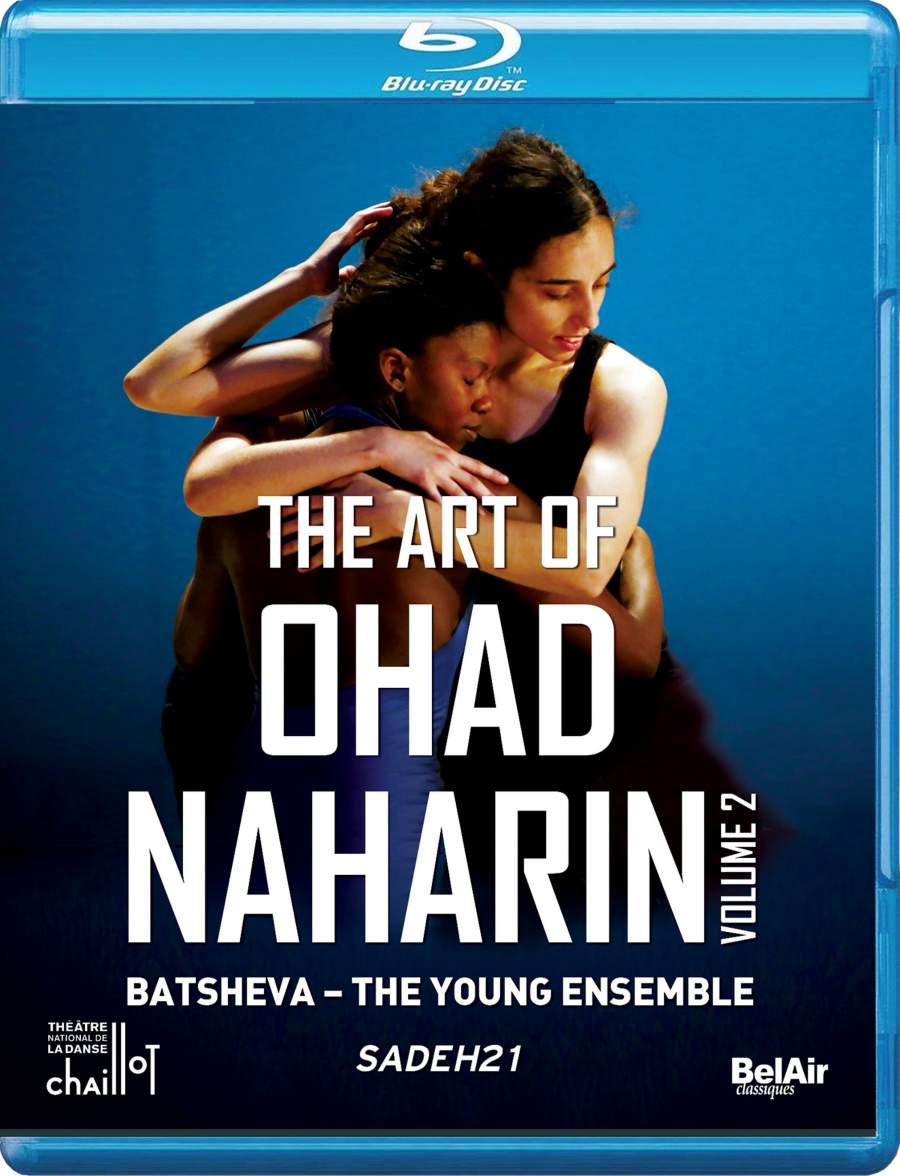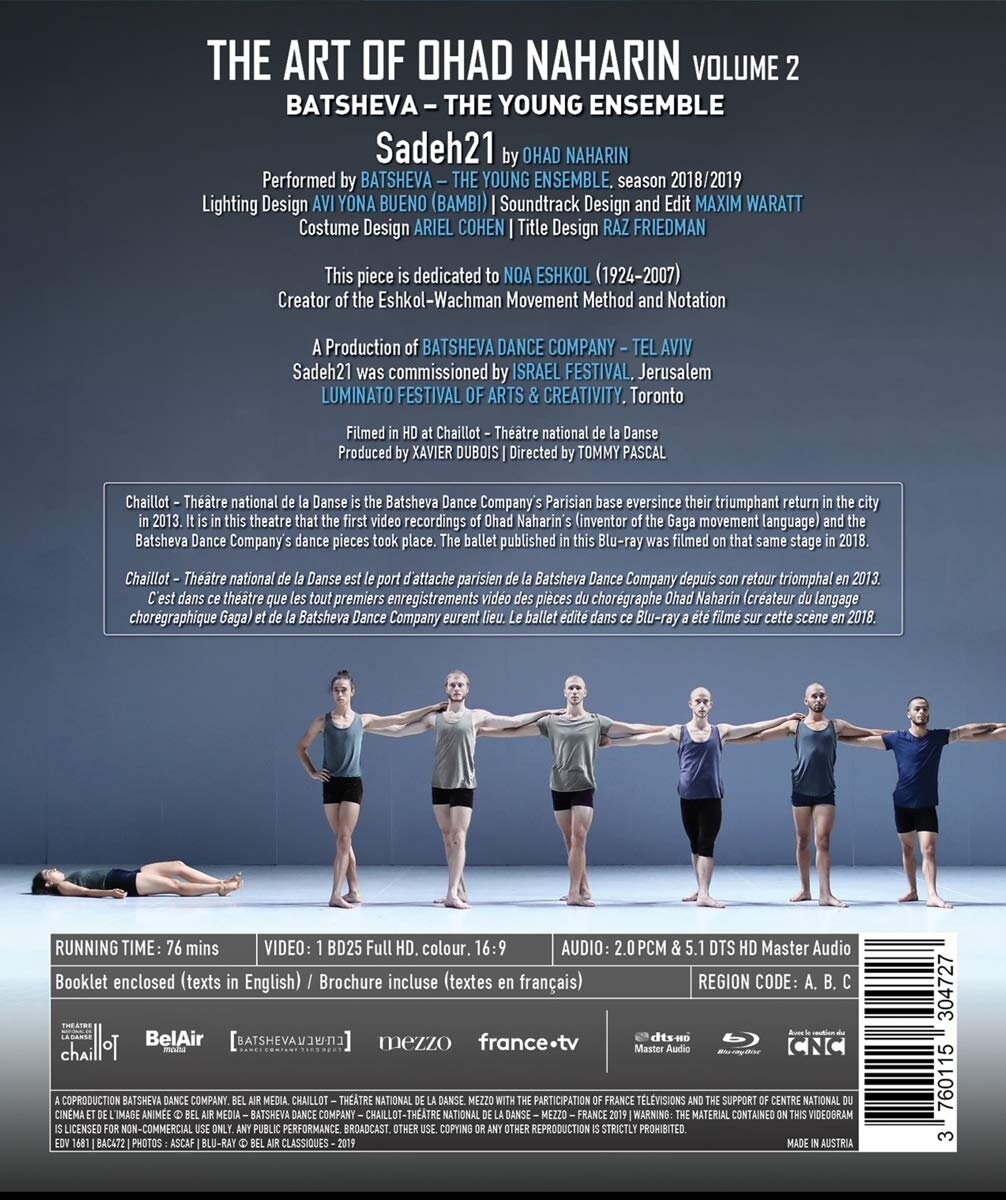

The Art of Ohad Naharin Vol. 2 is a performance in 2018 of Sadeh21, a 75-minute piece choreographed by Ohad Naharin in 2011. Recorded music from 10 modern composers. The venue was the same Chaillot-Théâtre national de la Danse in Paris where the early Art of Ohad Naharin (Vol. 1) was shot. Dancers from Batsheva-The Young Ensemble are Chen Agron, Gil Amishai, Cesar Brodermann, Ariel Gelbart, Londiwe Khoza, Béatrice Larrivée, Shir Levy, Federico Longo, Ohad Mazor, Robin Lesley Nimanong, Tom Nissim, Igor Ptashenchuk, Tamar Rosenzweig, Lihi Shochatovitch, Nicolas Ventura, Shaked Werner, Reches Itzhaki, and Avigail Shafrir. Costumes by Ariel Cohen; lighting by Avi Yona Bueno; soundtrack design by Maxim Waratt (a pseudenym for Ohad Naharin). Directed for TV by Tommy Pascal; produced by Xavier Dubois. Released 2019, disc has 2.0 stereo sound. Grade: A
Ohad Naharin is most famous as inventor of the Gaga movement language. Ohad’s mother was an expert in Feldenkrais therapy (exercise program for health and well-being). Ohad was apparently born with an extraordinary accurate sense of proprioception. As a mostly self-taught dancer he got hired by famous formal ballet choreographers even without the usual classic training: he could imitate like none other. But Ohad tired of any training based on restricting the movements of the body. Instead he invented Gaga: people should respond to their sense of proprioception to invent new movement forms. Gaga is like believing in God: anyone can do it any time, any where.
Eventually Ohad created at least 46 dance works and became director of Batsheva, the Israeli national dance company. Mr. Gaga became the best-selling documentary film ever in Israel. We now (December 2019) have two HDVDs about the Art of Ohad Naharin — Vol. 1 and Vol. 2. You should watch Vol. 2 first. It presents Sadeh21, a piece that focuses on the Gaga language itself in (what we call) etudes and improvisations. Vol. 1 presents several of Ohad’s more fully developed dance pieces based on Gaga movement.
Sadeh21
Gaga asks dancers to follow their sense of proprioception to invent as many movements as safety and good taste will allow. The word “sadeh” is Hebrew for “field” like in, say, “cotton field” or “field of study.” A dance stage is, of course, a field itself. The idea that a dance piece would have 21 fields of interest reminded us of, say, Chopin’s 24 Etudes for piano in which each study is in one of the 24 different musical keys. Well, the human body is vastly more complicated and amorphous than the 12 notes in Western music theory, so the analogy doesn’t hold up well. But when we watch Sadeh21, we get the feeling this might be the first piece new dancers at Batsheva get to work on.
Sadeh 1 is all solos with extreme gyrations (can’t see in screenshots) and weird positions like in our first two screenshots below. Probably this is mostly or entirely improvised:
Soon the show progresses to duets and small groups in Sadeh2:
Common components in the fields are humor and surrealism as seen in the next shot below. This can’t be achieved through individual improvisation, but only from choreography:
Next below, more choreography evident in masterful composition of a group image:
More mastery of composition below. 10 dancers are in the right side of the field. But the picture is balanced by the astonishing leap on the left side:
And next below balance is achieved with 4 bodies flat on the floor and 6 bodies in various elevated positions:
Batsheva is a no-star, egalitarian outfit. But Ohad looks for more than just movement ability. He looks for dancers who have something odd about them or, above all else, who can express “poetry” as well as agility in their movements. We are moving now into Sadeh3 with a solo, speaking part for the only black dancer in this group of 18 performers. Here the speaker isn’t saying anything profound. She speaks the names of numbers that add up to five. Then the five other dancers in the field form into positions representing the numbers called out — totally surreal:
Here the girl in blue called out “5.” The “architectural” response of the dancers below was too complicated to be improvised:
Moving into Sadeh 4 we have a guy pulling down his partner’s pants! Probably not something Ohad dreamed up. Probably an improvisation that then embedded in collective memory:
As more people enter the stage, choreography becomes more necessary:
And only the boss can change the lighting:
Now we are moving into Sadeh5. Many short pieces of interesting music are picked by Ohad through the pseudonym Maxim Waratt. Most of the dancing is not done to the beat of the music. But the scene next below is danced the beat of a jaunty jazz tune. The girls in the back make up a sexy chorus line while the soloist adopts a series of provocative but ironic poses in front:
We are still in Sadeh5 and the numbers get more complicated as the end of the show approaches. Next below we have 16 of the 18 dancers in a weird scene with the men wearing dresses:
Towards the end the fields become more compressed and focus on the 9 men as a corps. Now choreography is all as Ohad shows his ability to make even lines and formations of men dramatically interesting. The sole woman prone on the floor (beating her legs) is standard Ohad — he typically accents any mass image with an outlying exception to the crowd:
In the final two fields, all the dancers mount the rear wall from behind and fall or jump off the wall to the rear. There’s no suggestion what catches them:
The screenshots above and our comments give you pretty good introduction to the elements of Gaga. The official clip below (one of many on YouTube) show Gaga in action. Tommy Pascal provides great video with no motion issues and fine PQ. SQ is also fine. We give this the same A we gave to Volume 1 earlier.
OR


















